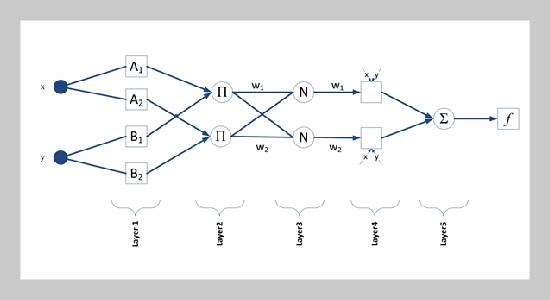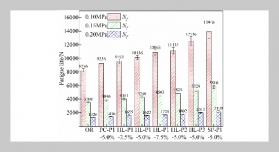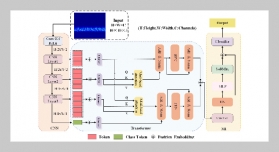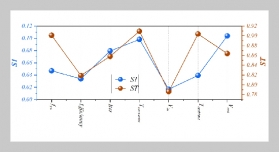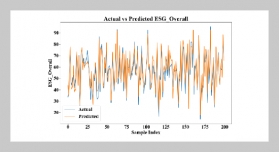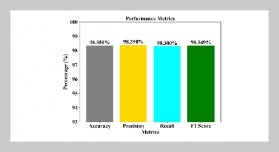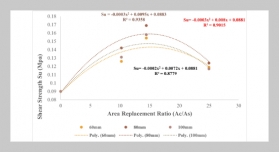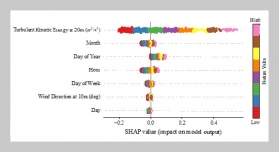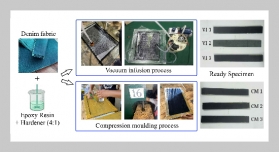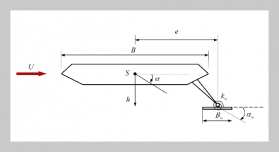- [1] M. H. Rafiei, W. H. Khushefati, R. Demirboga, and H. Adeli, (2017) “Supervised Deep Restricted Boltzmann Machine for Estimation of Concrete." ACI Materials Journal 114(2):
- [2] S. Lee, N.-H. Nguyen, A. Karamanli, J. Lee, and T. P. Vo, (2022) “Super learner machine-learning algorithms for compressive strength prediction of high performance concrete" Structural Concrete:
- [3] R. Sarkhani Benemaran, M. Esmaeili-Falak, and H. Katebi, (2020) “Physical and numerical modelling of pilestabilised saturated layered slopes" Proceedings of the Institution of Civil Engineers-Geotechnical Engineering: 1–16.
- [4] S. Bhanja and B. Sengupta, (2002) “Investigations on the compressive strength of silica fume concrete using statistical methods" Cement and Concrete Research 32(9): 1391–1394.
- [5] I. B. Topcu and M. Sarıdemir, (2008) “Prediction of compressive strength of concrete containing fly ash using artificial neural networks and fuzzy logic" Computational Materials Science 41(3): 305–311.
- [6] M. Esmaeili Falak and R. Sarkhani Benemaran, (2022) “Investigating the stress-strain behavior of frozen clay using triaxial test" Journal of Structural and Construction Engineering:
- [7] U. Anyaoha, A. Zaji, and Z. Liu, (2020) “Soft computing in estimating the compressive strength for highperformance concrete via concrete composition appraisal" Construction and Building Materials 257: 119472. DOI: 10.1016/j.conbuildmat.2020.119472.
- [8] U. Atici, (2011) “Prediction of the strength of mineral admixture concrete using multivariable regression analysis and an artificial neural network" Expert Systems with Applications 38(8): 9609–9618. DOI: 10.1016/j.eswa.2011.01.156.
- [9] M. Aghayari Hir, M. Zaheri, and N. Rahimzadeh, (2022) “Prediction of Rural Travel Demand by Spatial Regression and Artificial Neural Network Methods (Tabriz County)" Journal of Transportation Research:
- [10] R. Sarkhani Benemaran, M. Esmaeili-Falak, and A. Javadi, (2022) “Predicting resilient modulus of flexible pavement foundation using extreme gradient boosting based optimised models" International Journal of Pavement Engineering: 1–20.
- [11] R. S. Benemaran and M. Esmaeili-Falak, (2020) “Optimization of cost and mechanical properties of concrete with admixtures using MARS and PSO" Computers and Concrete 26(4): 309–316.
- [12] P. Chopra, R. K. Sharma, and M. Kumar, (2016) “Prediction of compressive strength of concrete using artificial neural network and genetic programming" Advances in Materials Science and Engineering 2016:
- [13] N.-H. Nguyen, T. P. Vo, S. Lee, and P. G. Asteris, (2021) “Heuristic algorithm-based semi-empirical formulas for estimating the compressive strength of the normal and high performance concrete" Construction and Building Materials 304: 124467. DOI: 10.1016/j.conbuildmat.2021.124467.
- [14] P. G. Asteris, A. D. Skentou, A. Bardhan, P. Samui, and K. Pilakoutas, (2021) “Predicting concrete compressive strength using hybrid ensembling of surrogate machine learning models" Cement and Concrete Research 145: 106449. DOI: 10.1016/j.cemconres.2021.106449.
- [15] S. Lai and M. Serra, (1997) “Concrete strength prediction by means of neural network" Construction and Building Materials 11(2): 93–98. DOI: 10.1016/S0950-0618(97)00007-X.
- [16] A. Baykaso˘glu, T. Dereli, and S. Tanı¸s, (2004) “Prediction of cement strength using soft computing techniques" Cement and concrete research 34(11): 2083–2090.
- [17] C. Yang, H. Feng, and M. Esmaeili-Falak, (2022) “Predicting the compressive strength of modified recycled aggregate concrete" Structural Concrete:
- [18] D.-K. Bui, T. Nguyen, J.-S. Chou, H. Nguyen-Xuan, and T. D. Ngo, (2018) “A modified firefly algorithmartificial neural network expert system for predicting compressive and tensile strength of high-performance concrete" Construction and Building Materials 180: 320– 333. DOI: 10.1016/j.conbuildmat.2018.05.201.
- [19] J. Yuan, M. Zhao, and M. Esmaeili-Falak, (2022) “A comparative study on predicting the rapid chloride permeability of self-compacting concrete using meta-heuristic algorithm and artificial intelligence techniques" Structural Concrete 23(2): 753–774. DOI: 10.1002/suco.202100682.
- [20] A. H. Gandomi and A. H. Alavi, (2012) “A new multigene genetic programming approach to nonlinear system modeling. Part I: materials and structural engineering problems" Neural Computing and Applications 21(1): 171–187.
- [21] S.-C. Lee, (2003) “Prediction of concrete strength using artificial neural networks" Engineering Structures 25(7): 849–857. DOI: 10.1016/S0141-0296(03)00004-X.
- [22] M. Khishe and M. R. Mosavi, (2020) “Chimp optimization algorithm" Expert systems with applications 149: 113338.
- [23] B. A. Young, A. Hall, L. Pilon, P. Gupta, and G. Sant, (2019) “Can the compressive strength of concrete be estimated from knowledge of the mixture proportions?: New insights from statistical analysis and machine learning methods" Cement and Concrete Research 115: 379–388. DOI: 10.1016/j.cemconres.2018.09.006.
- [24] S. Akkurt, G. Tayfur, and S. Can, (2004) “Fuzzy logic model for the prediction of cement compressive strength" Cement and concrete research 34(8): 1429–1433.
- [25] C. Leung. “Concrete as a Building Material”. In: Encyclopedia of Materials: Science and Technology. Elsevier, 2001, 1471–1479. DOI: 10.1016/B0-08-043152-6/00267-9.
- [26] I.-C. Yeh, (2003) “Prediction of strength of fly ash and slag concrete by the use of artificial neural networks" J. Chin. Inst. Civil Hydraul. Eng 15(4): 659–663.
- [27] I.-C. Yeh and L.-C. Lien, (2009) “Knowledge discovery of concrete material using genetic operation trees" Expert Systems with Applications 36(3): 5807–5812.
- [28] S. M. Mousavi, P. Aminian, A. H. Gandomi, A. H. Alavi, and H. Bolandi, (2012) “A new predictive model for compressive strength of HPC using gene expression programming" Advances in Engineering Software 45(1): 105–114.
- [29] M. Pala, E. Özbay, A. Özta¸s, and M. I. Yuce, (2007) “Appraisal of long-term effects of fly ash and silica fume on compressive strength of concrete by neural networks" Construction and Building Materials 21(2): 384–394. DOI: 10.1016/j.conbuildmat.2005.08.009.
- [30] X. Shi, X. Yu, and M. Esmaeili-Falak, (2023) “Improved arithmetic optimization algorithm and its application to carbon fiber reinforced polymer-steel bond strength estimation" Composite Structures 306: 116599. DOI: https://doi.org/10.1016/j.compstruct.2022.116599.
- [31] I.-C. Yeh, (1998) “Modeling Concrete Strength with Augment-Neuron Networks" Journal of Materials in Civil Engineering 10(4): 263–268. DOI: 10.1061/(ASCE)0899-1561(1998)10:4(263).
- [32] J.-S. Chou, W. K. Chong, and D.-K. Bui, (2016) “Nature-inspired metaheuristic regression system: programming and implementation for civil engineering applications" Journal of Computing in Civil Engineering 30(5): 4016007.
- [33] N. Leema, H. K. Nehemiah, and A. Kannan, (2016) “Neural network classifier optimization using differential evolution with global information and back propagation algorithm for clinical datasets" Applied Soft Computing 49: 834–844.
- [34] B. Bharatkumar, R. Narayanan, B. Raghuprasad, and D. Ramachandramurthy, (2001) “Mix proportioning of high performance concrete" Cement and Concrete Composites 23(1): 71–80. DOI: 10.1016/S0958-9465(00)00071-8.
- [35] M. Esmaeili-Falak and R. S. Benemaran, (2023) “Ensemble deep learning-based models to predict the resilient modulus of modified base materials subjected to wet-dry cycles" Geomechanics and Engineering:
- [36] I.-C. Yeh, (1998) “Modeling of strength of highperformance concrete using artificial neural networks" Cement and Concrete Research 28(12): 1797–1808. DOI: 10.1016/S0008-8846(98)00165-3.
- [37] M. Esmaeili-Falak, H. Katebi, and A. Javadi, (2018) “Experimental study of the mechanical behavior of frozen soils-A case study of tabriz subway" Periodica Polytechnica Civil Engineering 62(1): 117–125.
- [38] S. Afzal, B. M. Ziapour, A. Shokri, H. Shakibi, and B. Sobhani, (2023) “Building energy consumption prediction using multilayer perceptron neural network-assisted models; comparison of different optimization algorithms" Energy: 128446. DOI: 10.1016/j.energy.2023.128446.
- [39] D. V. Dao, H. Adeli, H.-B. Ly, L. M. Le, V. M. Le, T.-T. Le, and B. T. Pham, (2020) “A sensitivity and robustness analysis of GPR and ANN for high-performance concrete compressive strength prediction using a Monte Carlo simulation" Sustainability 12(3): 830.
- [40] J.-S. Jang, (1993) “ANFIS: adaptive-network-based fuzzy inference system" IEEE transactions on systems, man, and cybernetics 23(3): 665–685.
- [41] J.-S. Chou and A.-D. Pham, (2013) “Enhanced artificial intelligence for ensemble approach to predicting high performance concrete compressive strength" Construction and Building Materials 49: 554–563. DOI: 10.1016/j.conbuildmat.2013.08.078.
- [42] A. Neville and P.-C. Aïtcin, (1998) “High performance concrete—An overview" Materials and Structures 31(2): 111–117. DOI: 10.1007/BF02486473.
- [43] H. Nguyen, T. Vu, T. P. Vo, and H.-T. Thai, (2021) “Efficient machine learning models for prediction of concrete strengths" Construction and Building Materials 266: 120950.
- [44] M. FM Zain and S. M Abd, (2009) “Multiple regression model for compressive strength prediction of high performance concrete" Journal of applied sciences 9(1): 155–160.
- [45] J.-S. R. Jang, C.-T. Sun, and E. Mizutani, (1997) “Neuro-fuzzy and soft computing-a computational approach to learning and machine intelligence [Book Review]" IEEE Transactions on automatic control 42(10): 1482–1484.
- [46] K. Yan and C. Shi, (2010) “Prediction of elastic modulus of normal and high strength concrete by support vector machine" Construction and Building Materials 24(8): 1479–1485. DOI: 10.1016/j.conbuildmat.2010.01.006.
- [47] M. S. Khorsheed and A. O. Al-Thubaity, (2013) “Comparative evaluation of text classification techniques using a large diverse Arabic dataset" Language resources and evaluation 47(2): 513–538.
- [48] Q. Han, C. Gui, J. Xu, and G. Lacidogna, (2019) “A generalized method to predict the compressive strength of high-performance concrete by improved random forest algorithm" Construction and Building Materials 226: 734–742. DOI: 10.1016/j.conbuildmat.2019.07.315.
- [49] T. Le-Duc, Q.-H. Nguyen, and H. Nguyen-Xuan, (2020) “Balancing composite motion optimization" Information Sciences 520: 250–270. DOI: 10.1016/j.ins.2020.02.013.
- [50] M. Esmaeili-Falak, H. Katebi, M. Vadiati, and J. Adamowski, (2019) “Predicting Triaxial Compressive Strength and Young’s Modulus of Frozen Sand Using Artificial Intelligence Methods" Journal of Cold Regions Engineering 33(3): 04019007. DOI: 10.1061/(ASCE)CR.1943-5495.0000188.
- [51] I.-C. Yeh, (1999) “Design of high-performance concrete mixture using neural networks and nonlinear programming" Journal of Computing in Civil Engineering 13(1): 36–42.
- [52] A. Özta¸s, M. Pala, E. Özbay, E. Kanca, N. Çagˇlar, and M. A. Bhatti, (2006) “Predicting the compressive strength and slump of high strength concrete using neural network" Construction and Building Materials 20(9): 769–775. DOI: 10.1016/j.conbuildmat.2005.01.054.
- [53] M. Sarıdemir, (2009) “Predicting the compressive strength of mortars containing metakaolin by artificial neural networks and fuzzy logic" Advances in Engineering Software 40(9): 920–927.
- [54] J.-S. Chou and C.-F. Tsai, (2012) “Concrete compressive strength analysis using a combined classification and regression technique" Automation in Construction 24: 52–60.
- [55] M. H. F. Zarandi, I. B. Türksen, J. Sobhani, and A. A. Ramezanianpour, (2008) “Fuzzy polynomial neural networks for approximation of the compressive strength of concrete" Applied Soft Computing 8(1): 488–498.
- [56] I.-C. Yeh, (2006) “Analysis of strength of concrete using design of experiments and neural networks" Journal of Materials in Civil Engineering 18(4): 597–604.
- [57] J. Namyong, Y. Sangchun, and C. Hongbum, (2004) “Prediction of compressive strength of in-situ concrete based on mixture proportions" Journal of Asian Architecture and Building Engineering 3(1): 9–16.
- [58] H.-G. Ni and J.-Z. Wang, (2000) “Prediction of compressive strength of concrete by neural networks" Cement and Concrete Research 30(8): 1245–1250. DOI: 10.1016/S0008-8846(00)00345-8.
- [59] F. Masoumi, S. Najjar-Ghabel, A. Safarzadeh, and B. Sadaghat, (2020) “Automatic calibration of the groundwater simulation model with high parameter dimensionality using sequential uncertainty fitting approach" Water Supply 20(8): 3487–3501. DOI: 10.2166/ws.2020.241.
- [60] R. Sarkhani Benemaran, (2023) “Application of extreme gradient boosting method for evaluating the properties of episodic failure of borehole breakout" Geoenergy Science and Engineering: 211837. DOI: 10.1016/j.geoen. 2023.211837.


